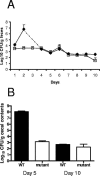A prfA transposon mutant of Listeria monocytogenes F2365, a serotype 4b strain, is able to survive in the gastrointestinal tract but does not cause systemic infection of the spleens and livers of intragastrically inoculated mice
- PMID: 16239554
- PMCID: PMC1273849
- DOI: 10.1128/IAI.73.11.7517-7524.2005
A prfA transposon mutant of Listeria monocytogenes F2365, a serotype 4b strain, is able to survive in the gastrointestinal tract but does not cause systemic infection of the spleens and livers of intragastrically inoculated mice
Abstract
prfA is a member of the Crp/Fnr family of global regulatory genes in Listeria monocytogenes that has been shown previously to regulate several key virulence determinants both in vitro and in parenterally inoculated laboratory rodents. However, the role of prfA in the ability of L. monocytogenes to cause infection via the gastrointestinal (GI) tract has not been clearly established. In this study, we used a prfA transposon mutant of L. monocytogenes F2365, a serotype 4b strain, to assess the role of prfA in the pathogenesis of gastrointestinal listeriosis in mice. We found that the prfA mutant was able to survive in the GI tract (i.e., cecum) of mice, albeit in numbers somewhat less than those of the wild-type parent strain of L. monocytogenes. However, mice inoculated with the prfA mutant did not exhibit systemic infection of the spleen and liver, as was noted for mice inoculated with the wild-type parent strain. Survival of the prfA mutant in synthetic gastric fluid at pH 2.5 or 5 was somewhat reduced compared to that of the wild-type strain, as was its ability to invade and multiply within differentiated human intestinal epithelial cells (Caco-2 cells). Prior infection with the prfA mutant gave mice some protection against a subsequent challenge with virulent L. monocytogenes, although much less than that gained by prior gastrointestinal infection with the wild-type parent strain. These findings indicate that the global regulatory gene prfA is dispensable for colonization of the GI tract in mice but not for systemic infection.
Figures







References
-
- Bubert, A., Z. Sokolovic, S. K. Chun, L. Papatheodoro, A. Simm, and W. Goebel. 1999. Differential expression of Listeria monocytogenes virulence genes in mammalian host cells. Mol. Gen. Genet. 261:323-336. - PubMed
-
- Cabanes, D., P. Dehoux, O. Dussurget, L. Frangeul, and P. Cossart. 2002. Surface proteins and the pathogenic potential of Listeria monocytogenes. Trends Microbiol. 10:238-245. - PubMed
-
- Cabanes, D., O. Dussurget, P. Dehoux, and P. Cossart. 2004. Auto, a surface associated autolysin of Listeria monocytogenes required for entry into eukaryotic cells and virulence. Mol. Microbiol. 51:1601-1614. - PubMed
Publication types
MeSH terms
Substances
LinkOut - more resources
Full Text Sources
Research Materials
Miscellaneous

